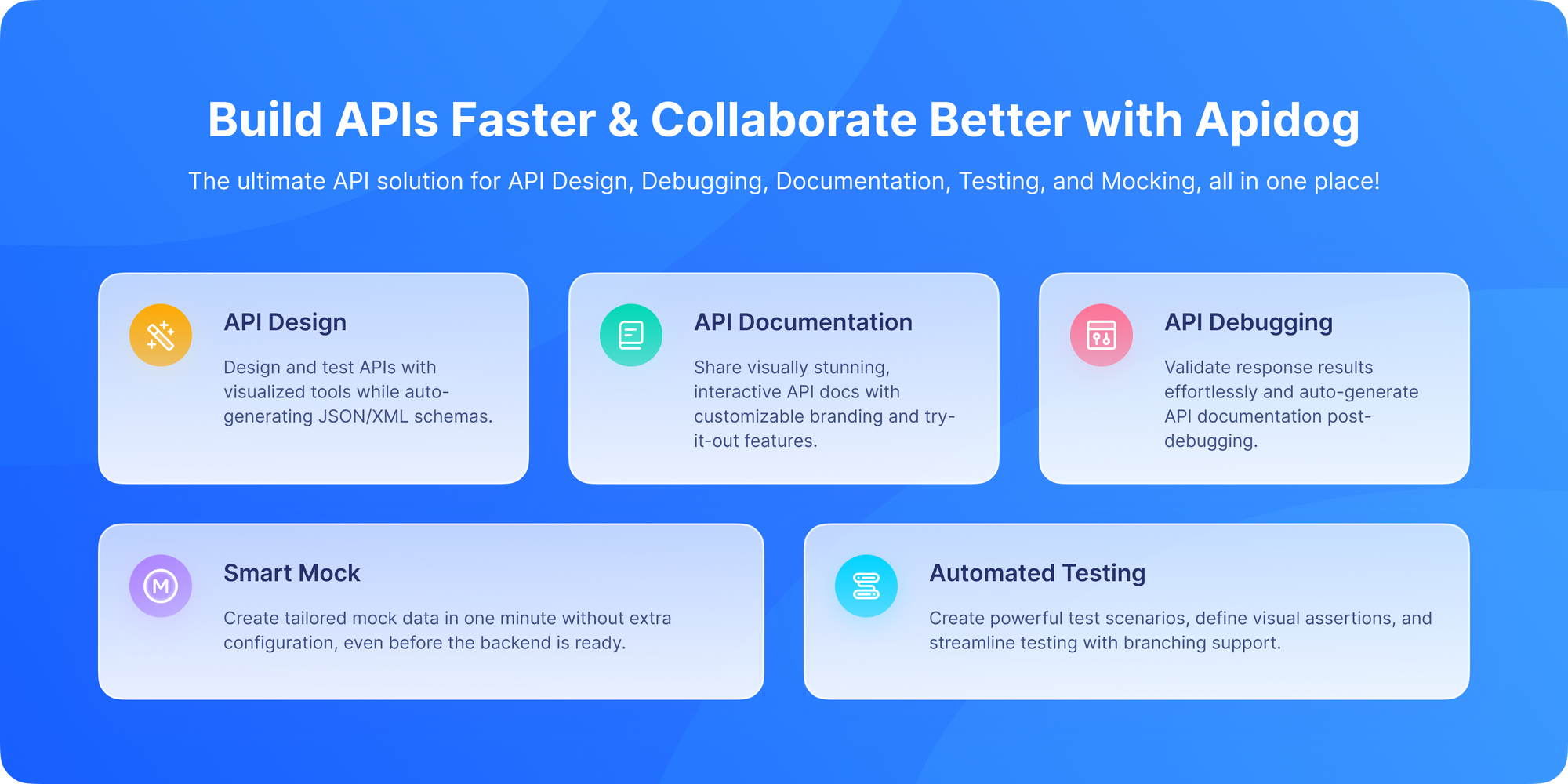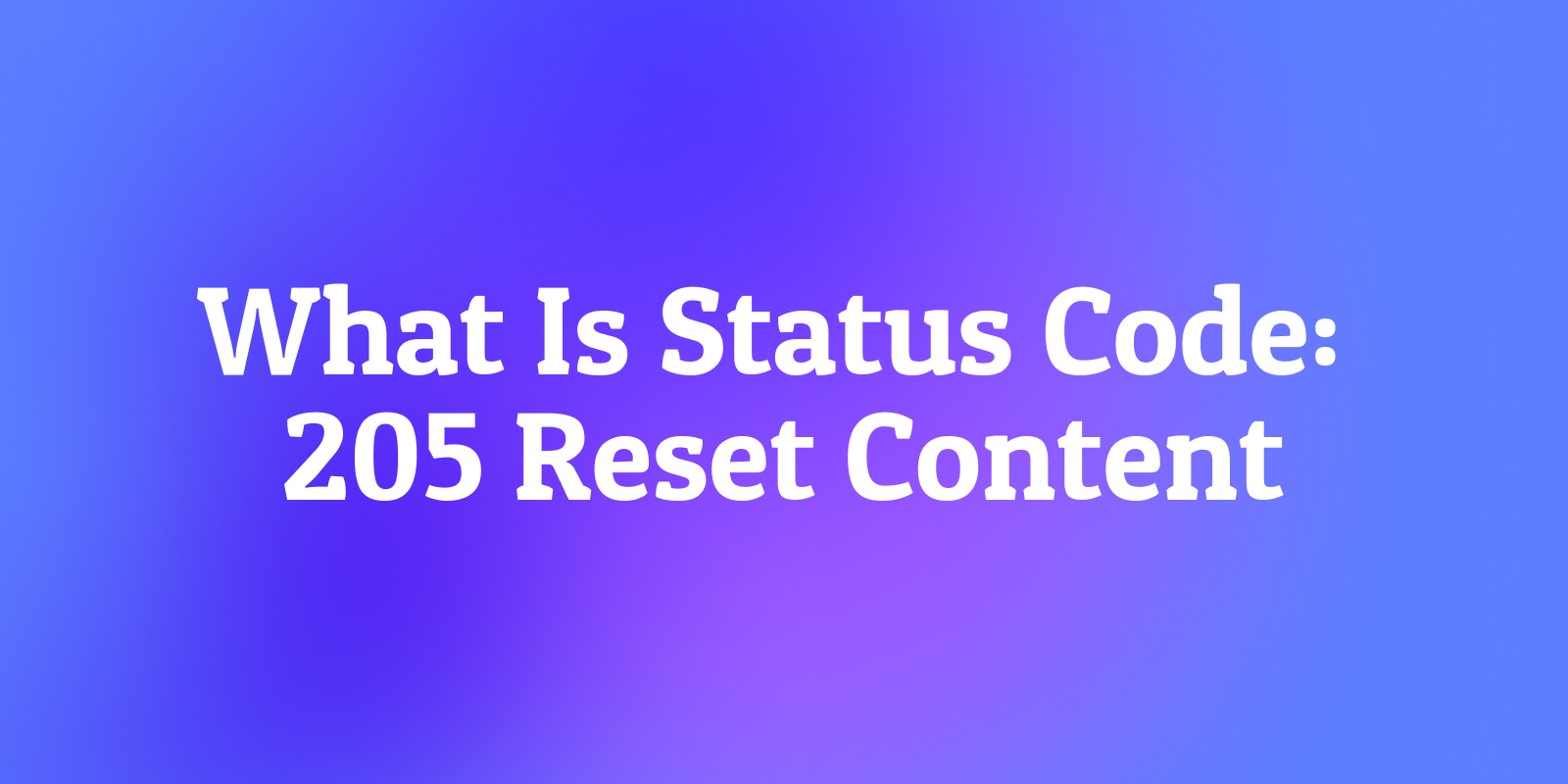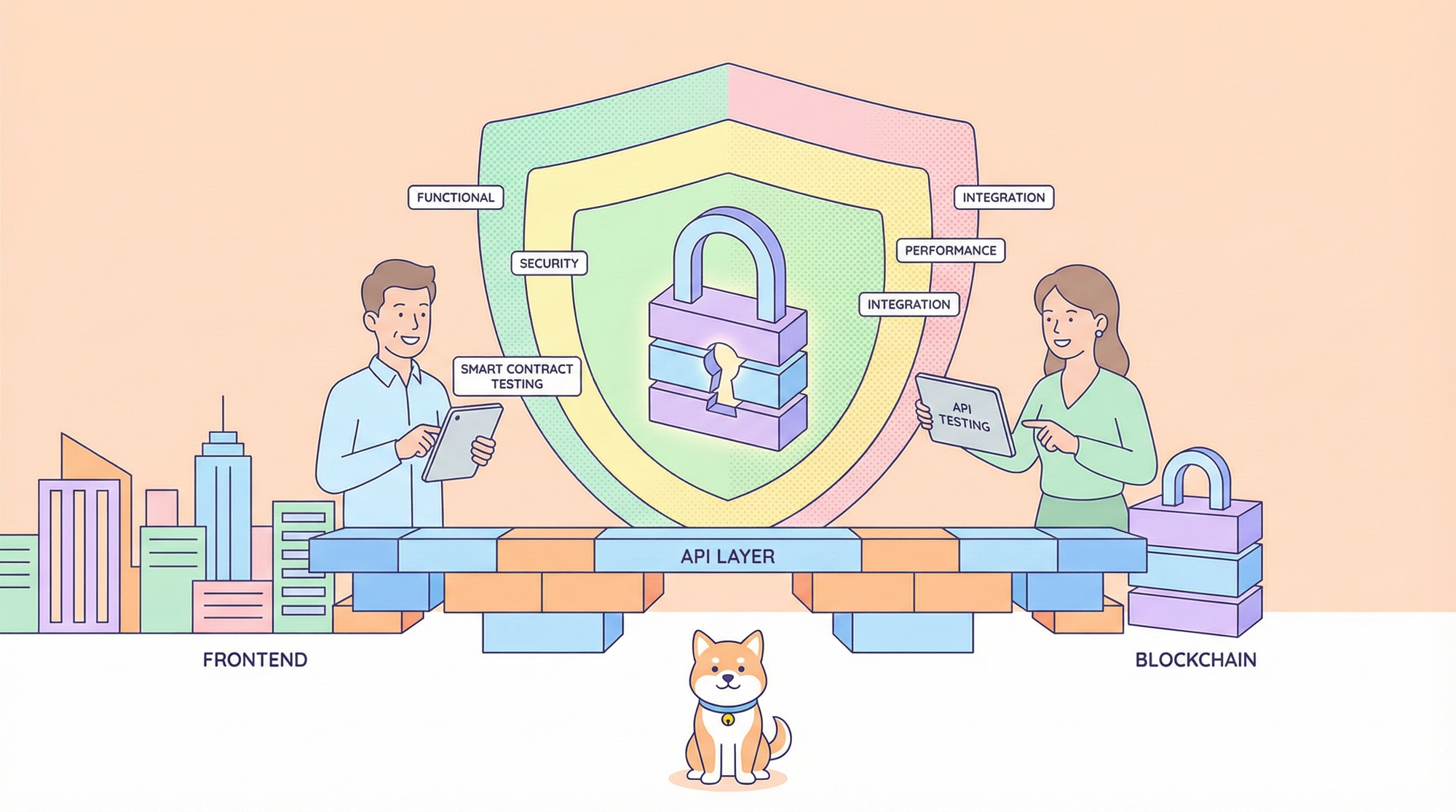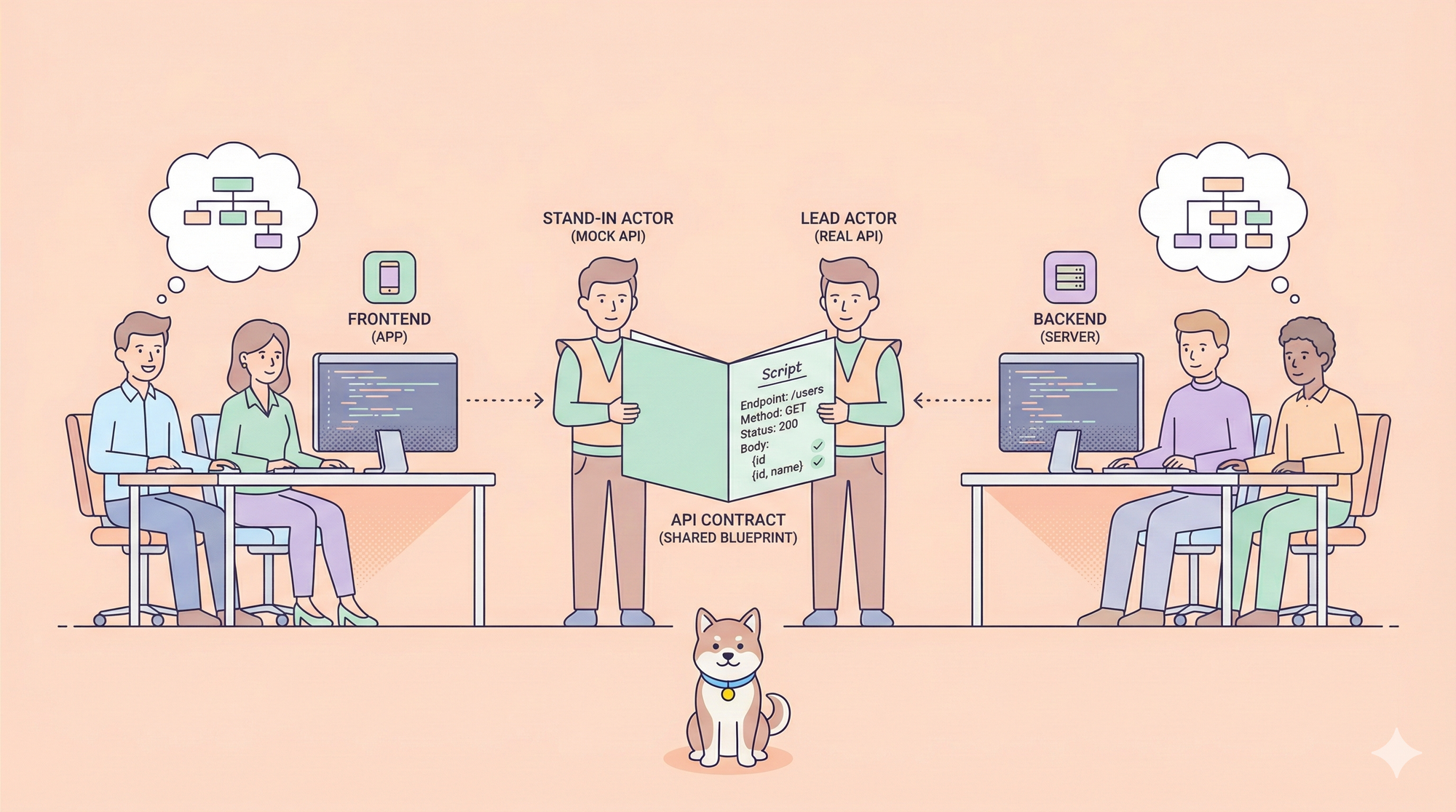You're filling out a long, complex web form maybe a tax application or a detailed configuration page. You hit "Submit," and something goes wrong. Maybe there's a validation error on a field you didn't see. Frustrated, you hit the browser's back button, only to find that all the data you painstakingly entered is still there, a ghost of your failed attempt. Now you have to manually clear dozens of fields to start over.
What if there was a way for the server to tell your browser: "Submission received. Now, please clear the form so the user can start fresh."?
This is the very specific, hyper-niche job of one of HTTP's most obscure status codes: 205 Reset Content.
While its cousins like 200 OK and 404 Not Found are household names in the development world, 205 is the mysterious relative that shows up to few parties. But when used correctly, it can solve a very particular user experience problem with elegance and precision.
It's the server's way of saying, "I got what you sent me. The transaction is complete. Now, as your next instruction, please reset your current view to a blank state, ready for the next input."
If you're a developer building form-heavy applications or APIs that interact with client state, understanding this code is a fascinating deep dive into the nuances of HTTP.
And before we explore this rare gem, if you're building or testing APIs that manage client state, you need a tool that can handle every HTTP nuance, you don’t need to set up an entire backend. Download Apidog for free; it's an all-in-one API platform that allows you to test and validate even the most obscure status codes, ensuring your application's behavior is robust and intentional. With Apidog, you can simulate a 205 response instantly and see how your client behaves. Best of all, you can download it for free.
Now, let's unravel the purpose, history, and practical application of the HTTP 205 Reset Content status code.
The State of the Web
To understand 205, we need to travel back in time to a slightly different web. The code was defined in the HTTP/1.1 specification (RFC 2616) in 1999, a time when web applications were often simpler and the line between a website and a desktop application was more distinct.
The philosophy behind 205 is inspired by the behavior of terminal applications or desktop software. Imagine using a command-line tool. You type a command and press Enter. The command executes, and then you are presented with a fresh, empty prompt, ready for your next instruction. The 205 status code was designed to bring this same pattern to the web.
What Does HTTP 205 Reset Content Actually Mean?
The HTTP 205 Reset Content status code is a way for a server to tell the client: "Your request was successfully processed, but now you should reset the document view or user interface."
The official definition from the RFC is:
The server has fulfilled the request and the user agent SHOULD reset the document view which caused the request to be sent. This response is primarily intended to allow input for actions to take place via user input, followed by a clearing of the form in which the input is given so that the user can easily initiate another action.
Let's break down the key phrases:
- "The server has fulfilled the request...": Like
204 No Content, this is a success code. The request was valid and was processed correctly. - "...the user agent SHOULD reset the document view...": This is the crucial instruction. The server is suggesting that the client (the "user agent," like a browser) should clear the interface.
- "...which caused the request to be sent.": This typically refers to a form that was submitted.
- "...so that the user can easily initiate another action.": The ultimate goal: to improve user experience by providing a clean slate.
In simplest terms, a 205 response means: "Success. Now, please clear the form."
Unlike the 204 No Content status code, which indicates a successful response with no body, 205 goes a step further by asking the client to clear or reset any input forms, selections, or states related to the resource or user interface. In web applications, this often means clearing form fields or resetting page elements to their initial states.
For example, after submitting a form or completing a user action, the server might respond with a 205 status to signal that the UI should be reset because the operation is done and the form data should be cleared.
Why Do We Need 205 Reset Content?
If you've ever filled out a web form, hit "Submit", and then noticed the fields were still filled in, you know it can be awkward. Sometimes you want to clear everything so the user knows the submission was successful and they can enter new data if needed.
That's exactly why 205 exists. It gives the server a way to instruct the client:
- "Reset all form fields."
- "Refresh the document view to its default state."
This creates a better user experience by preventing accidental duplicate submissions.
Why Does the 205 Reset Content Status Code Exist?
You might be wondering, why do we even have this status code? Couldn't we just use 200 or 204 for these cases?
The main purpose of 205 Reset Content is to improve user experience by signaling the client that it should reset UI components after completing an action.
This becomes important in interactive applications or web forms where the user needs to start fresh after an action has been acknowledged as successful. Sending this signal helps avoid confusion, prevents the user from re-submitting old data, and creates a smoother interaction flow.
In other words, 205 provides semantic clarity and efficient control over the UI state, which generic success codes cannot convey.
How It Works: A Theoretical Example
Let's imagine a classic use case: a user submitting a command via a web-based terminal.
1. The Client Request: A user types a command like ping example.com into a web-based shell and hits Enter. The browser sends this to the server.
POST /api/command HTTP/1.1Host: web-shell.example.comContent-Type: application/json
{"command": "ping example.com"}
2. Server Processing: The server receives the command, executes it, and captures the output.
3. The 205 Response: Instead of just returning the output, the server wants the input field to clear. It responds:
HTTP/1.1 205 Reset ContentContent-Type: text/plain
PING example.com (93.184.216.34): 56 data bytes
64 bytes from 93.184.216.34: icmp_seq=0 ttl=54 time=23.671 ms
Wait a minute! Did you spot the contradiction? The status code says "Reset Content," but there is content (the ping output). This highlights the practical ambiguity of 205.
4. Client Behavior: Upon receiving a 205 status code, a theoretically compliant browser would then:
- a) Render the response body (showing the ping results).
- b) Reset the document view, which would clear the form input field where the user typed
ping example.com.
This allows the user to see the result of their command and immediately have a blank input ready for the next command.
Key Characteristics of 205
Here's what sets 205 apart:
- It's a success code: Like other 2xx responses, it means the request was successful.
- It must not include a body: Similar to 204, the response body is empty.
- It carries intent: The intent is different it explicitly tells the client to reset its state.
- It's rare: Not all browsers or clients fully respect 205 instructions.
When to Use 205 Reset Content?
Here are some typical scenarios where a 205 status can be beneficial:
- After Form Submission: Once users submit a form successfully, the server can respond with 205 to clear the form fields and prevent duplicates.
- Resetting Interactive Fields: In applications where users input data, 205 can signal resetting dropdowns, toggles, or other input fields.
- Feedback Loops: When a server accepts user input and doesn’t need to return additional data but wants the UI reset for further input.
- Clear Cache or State: Some apps might use 205 to instruct clearing local state or cached form content.
205 vs. 204 No Content: What's the Difference?
This is the most important comparison. They are easily confused but serve distinct purposes.
204 No Content: Means "I succeeded, and I have nothing to tell you." The client should not change its view. It's often used forDELETEorPUToperations where the client already has all the state it needs. The client's UI might remove an item from a list or update a toggle, but it won't clear a form.
- Analogy: You tell your smart speaker, "Turn off the lights." It responds with a beep (a
204). The lights are off, and the speaker has nothing to add.
2. 205 Reset Content: Means "I succeeded, and I'm telling you to clear your input." The client should change its view by resetting the form that generated the request. The response often will contain a body with the result of the action.
- Analogy: You type a calculation into a physical calculator:
2 + 2 =. It shows you the answer4and then immediately clears the display to0, ready for your next calculation. The4is the response body; the clearing is the205instruction.
In short:
- 204 = Silence is golden.
- 205 = Success, now reset the view.
The presence of a response body is the key differentiator. A 204 must have an empty body. A 205 can have a body, but its primary function is to instruct the client to reset its input.
205 vs 200: Another Common Confusion
200 OK is the most common success code, so why not just use that?
- 200 OK: The request succeeded, and there may be content to return.
- 205 Reset Content: The request succeeded, but instead of returning data, the server instructs the client to reset the view.
So while 200 OK leaves the UI unchanged, 205 explicitly asks for a reset.
How Should Clients Handle 205 Responses?
When a client receives a 205 Reset Content status code, it should:
- Clear or reset the input fields and UI components related to the request.
- Avoid expecting any response body because 205 responses usually do not contain content.
- Continue normal operations, knowing that the last user action was processed successfully.
- Handle any custom client-side logic linked to resetting views or forms.
Browsers and API clients might interpret 205 differently based on implementation, but developers should tailor their UI logic to listen for 205 status codes and respond accordingly.
Implementing 205 Reset Content in Your API
If you are designing an API or web service, here are some tips on how to implement 205 responses effectively:
- Use 205 where the client needs to refresh the input interface after submission.
- Avoid sending a response body with a 205 response to adhere to HTTP standards.
- Document clearly when your API will return 205 and how clients should behave.
- Test thoroughly using API testing tools to confirm client compatibility.
The Reality: Why You Almost Never See 205
Despite being a fascinating idea, the 205 status code is incredibly rare in the wild. Here's why:
- Lack of Browser Support: This is the biggest reason. The HTTP spec says the user agent "SHOULD" reset the document view, not "MUST." This weak language means browser vendors never prioritized implementing this behavior. If you send a
205to a modern browser, it will likely just render the response body and do absolutely nothing to the form. The "reset" instruction is silently ignored.
2. The Rise of JavaScript: Modern web development is dominated by JavaScript-driven Single Page Applications (SPAs). Developers have full control over the UI. If they want to clear a form after submission, they don't need a special HTTP status code from the server; they just do it directly in the client-side code after receiving a 200 or 201 response.
// Modern, common approach
fetch('/api/submit-form', { method: 'POST', body: formData })
.then(response => response.json())
.then(data => {
// 1. Show a success message with the data
showSuccess(data);
// 2. Programmatically clear the form
formElement.reset();
});
This approach is more reliable and explicit than relying on a browser to interpret a 205.
3. Ambiguity: The tension between "reset the view" and "here is a response body" creates confusion. Should the client display the body and then clear the form? What part of the "view" should be reset? This ambiguity led to poor adoption.
Niche Use Cases Where 205 Could Shine
While largely obsolete in modern web development, the concept of 205 can still be applied in specific contexts:
- APIs for Embedded Devices/IoT: Imagine an API for a smart kiosk or a terminal. A client application built specifically for this kiosk could be programmed to understand and obey the
205command, using it to reset its interface after a transaction is complete. - Command-Line HTTP Clients: A custom CLI tool that interacts with an API could be designed to clear its input line upon receiving a
205, mimicking the behavior of a shell. - Educational or Conceptual APIs: If you're building an API to demonstrate HTTP semantics, implementing
205is a great way to showcase its intended purpose.
Testing 205 Responses with Apidog

Understanding less common status codes such as 205 can be tricky, especially when building complex applications with many endpoints. Even if browsers don't support it, you might need to test an API that returns 205 or implement one for a specialized client. Apidog is perfect for this kind of niche testing.
With Apidog, you can:
- Simulate the Response: Set up a mock endpoint in Apidog that returns a
205status code with a specific body. - Test Specialized Clients: If you're building a custom client that does obey
205, you can use Apidog to mock the server and ensure your client correctly clears its input upon receiving this status. - Validate API Behavior: Use Apidog to send requests to your API and verify that it returns the expected
205status under the right conditions. - Document the Intent: Even if the effect isn't automatic, you can document in your Apidog project that a certain endpoint returns
205to indicate the client should reset its input, providing crucial information to other developers.
Whether you are building RESTful APIs or interactive web applications, Apidog makes it easier to handle status codes like 205 correctly. For developers curious about obscure status codes like 205, Apidog makes experimentation painless.
Benefits of Using 205 Properly
- Improved UX: Helps prevent duplicate submissions.
- Efficiency: Reduces the need for extra scripts to reset forms manually.
- Clarity: Communicates intent more clearly than just 204.
- Standards compliance: Sticks to the HTTP spec, making APIs predictable.
Common Misuses of 205 Reset Content
Unfortunately, developers sometimes misuse it:
- Returning 205 with a body → Against the spec.
- Using 205 for GET requests → GET should not reset content.
- Overusing it → Not every success needs a reset.
Best Practices for Implementing 205 in REST APIs
- Use 205 primarily for POST requests with form submissions.
- Don’t send a response body.
- Make sure your clients (browsers, apps) support 205 behavior.
- Document it clearly in your API spec.
205 in Forms, Browsers, and APIs
- Forms: The main use case clear after submission.
- Browsers: Support for 205 is inconsistent. Some ignore the reset instruction.
- APIs: Many API consumers don’t automatically reset views. You may need client-side logic to enforce it.
205 in Modern Protocols Beyond REST
- GraphQL: Doesn’t have a native equivalent, since queries always return data.
- gRPC: Similar logic can be implemented, but not tied to HTTP codes.
- Single Page Applications (SPAs): Developers often mimic 205 behavior using frontend frameworks rather than relying on the server.
Common Misinterpretations of 205 Reset Content
Let's address some misunderstandings to give you clearer insight:
- 205 is an error: No, 205 indicates success with a specific instruction.
- 205 means reload the page: Not exactly, it means reset the relevant UI elements, not necessarily reloading the whole page.
- 205 allows sending content: The HTTP/1.1 specification states that 205 responses must not include a message body.
- Clients automatically reset UI: Only if the client is programmed to handle 205 accordingly.
Educating clients on handling 205 correctly is important for an optimal user experience.
How 205 Fits Into Modern Web Applications
In rich client-side apps and Single Page Applications (SPAs), control over UI state is crucial. Using 205 Reset Content responses lets backend APIs control frontend UI behavior more precisely.
For example, after a user submits a comment on a blog post, the client might receive a 205 response, triggering the comment form to clear, ready for a new input. This streamlines user interactions and avoids UI confusion.
Coding Examples: How to Send a 205 Reset Content Response
Here's a simple example using Node.js and Express:
javascriptapp.post('/submit-form', (req, res) => { *// Handle form submission logic here// ...// Send 205 Reset Content response* res.status(205).send(); });
This tells the client that the form was submitted successfully and that the UI should be reset accordingly.
Best Practices: A Historical Curiosity
The HTTP 205 Reset Content status code is a fascinating relic of a different era of web design. It represents a time when there was a stronger desire to push behavioral logic from the server to the client using the semantics of HTTP itself.
Today, the best practice is clear:
- For Server Developers: It's generally safe to avoid using
205 Reset Content. Rely on a200 OKor201 Createdresponse and let the client application handle UI changes like clearing a form. This is more predictable and widely supported. - For Client Developers: Don't write code that expects browsers to handle
205automatically. Explicitly handle form reset logic in your JavaScript after a successful response.
Conclusion: Embrace the 205 Reset Content Status Code for Better UI Feedback
The HTTP status code 205 Reset Content might be one of the most overlooked status codes, but it plays a pivotal role in delivering clear UI instructions after successful actions. Unlike generic success codes, 205 uniquely signals the client to reset forms or views, improving user experience and preventing unwanted duplicate inputs. However, because not all clients respect it, you'll need to decide carefully whether to use it or implement resets manually. While you may never actively use 205 in your career, understanding it provides a deeper appreciation for the design and evolution of the HTTP protocol. It's a reminder that for every common, workhorse status code, there are others that solved very specific problems in the architecture of the web.
If you want to ensure your APIs handle 205 responses correctly or want to test your API responses comprehensively, make sure to download Apidog for free. Apidog makes it simple to test, document, and monitor your API’s behavior, including status codes like 205, so you're always in full control of your application's communication. You can simulate 205 responses, test client behavior, and document when it's appropriate, all without writing a single backend line.
If you're building or testing APIs, don't just ignore the lesser-known status codes. They exist for a reason, and when used properly, they can improve both user experience and developer clarity.



